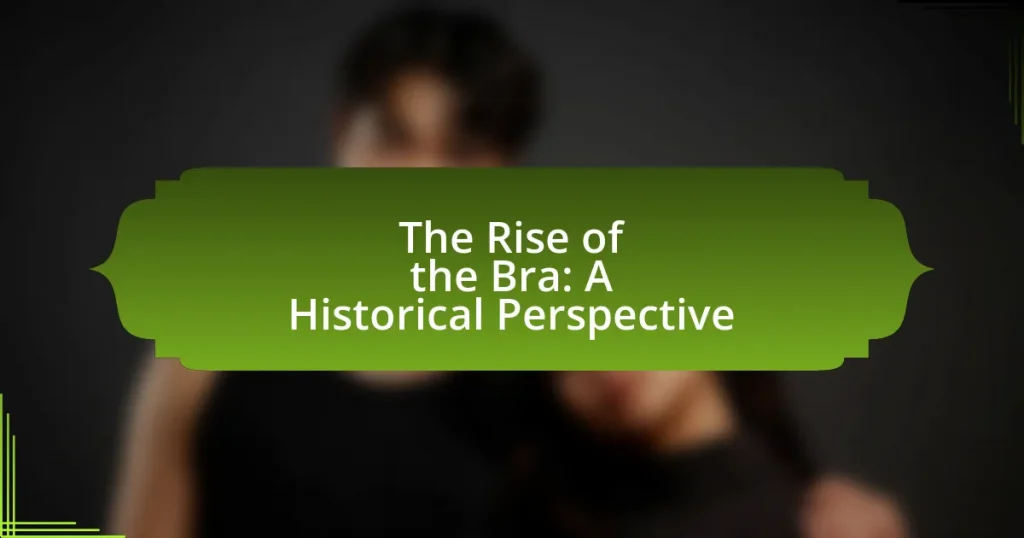Lingerie serves as a reflection of societal changes, evolving significantly over the decades in response to shifts in fashion, women’s roles, and cultural attitudes. The article explores the transformation of lingerie from the restrictive corsets of the early 20th century to the inclusive and body-positive designs of today, highlighting key influences such as the women’s liberation movement, pop culture, and advancements in materials and technology. It also examines how contemporary brands address issues of diversity and sustainability, shaping the current lingerie market. Through this analysis, the article illustrates how lingerie not only fulfills a functional purpose but also embodies the changing perceptions of femininity and empowerment throughout history.

How has lingerie evolved over the decades?
Lingerie has evolved significantly over the decades, reflecting changes in societal norms, fashion trends, and women’s roles. In the 1920s, the flapper era introduced more relaxed silhouettes, moving away from restrictive corsets to bras and slips that emphasized a boyish figure. The 1950s saw the rise of the hourglass shape, with padded bras and girdles becoming popular, influenced by icons like Marilyn Monroe. The 1960s and 1970s brought about a revolution with the feminist movement, leading to the introduction of more comfortable and practical designs, such as bralettes and the rejection of traditional undergarments. By the 1980s and 1990s, lingerie became a fashion statement, with bold colors and lace becoming mainstream, influenced by pop culture and celebrities. Today, lingerie continues to evolve with a focus on inclusivity and body positivity, offering a wide range of sizes and styles that cater to diverse body types and preferences. This evolution illustrates how lingerie not only serves a functional purpose but also mirrors the changing attitudes towards femininity and empowerment throughout history.
What societal changes have influenced lingerie design?
Societal changes such as the women’s liberation movement, evolving body positivity standards, and shifts in fashion trends have significantly influenced lingerie design. The women’s liberation movement of the 1960s and 1970s led to a demand for more functional and comfortable lingerie, moving away from restrictive designs. Additionally, the rise of body positivity in the 1990s and 2000s encouraged brands to create diverse sizing and styles that celebrate all body types. Furthermore, contemporary fashion trends emphasize inclusivity and sustainability, prompting lingerie designers to incorporate eco-friendly materials and ethical production practices. These societal shifts have collectively shaped lingerie into a reflection of women’s empowerment, comfort, and individuality.
How did the World Wars impact lingerie styles?
The World Wars significantly transformed lingerie styles by shifting from elaborate designs to more practical and functional garments. During World War I, the need for women to enter the workforce led to the adoption of simpler, less restrictive undergarments, such as the brassiere, which replaced corsets. This change was influenced by the wartime necessity for comfort and mobility, as women took on roles traditionally held by men.
In World War II, the impact continued with the introduction of rationing, which limited the availability of materials. As a result, lingerie became more utilitarian, focusing on basic shapes and designs that used fewer resources. The emergence of synthetic fabrics, like nylon, also began during this period, allowing for lighter and more affordable lingerie options. These shifts reflected broader societal changes, as women gained more independence and began to prioritize comfort and practicality in their clothing choices.
What role did feminism play in lingerie evolution?
Feminism significantly influenced the evolution of lingerie by challenging traditional gender norms and advocating for women’s autonomy over their bodies. The feminist movements of the 1960s and 1970s, particularly the second wave, promoted the idea that women should have the freedom to choose how they present themselves, including their undergarments. This led to a shift from restrictive, often uncomfortable lingerie designed for male pleasure to more comfortable, functional, and empowering options that prioritize women’s needs and preferences. For instance, the introduction of the bralette and the rejection of the corset reflected a broader societal change towards body positivity and self-acceptance, aligning with feminist ideals. Additionally, feminist critiques of the fashion industry have encouraged brands to embrace diversity in body types and promote lingerie that celebrates rather than objectifies women.
How do cultural shifts reflect in lingerie trends?
Cultural shifts significantly influence lingerie trends by altering societal perceptions of femininity, body image, and sexuality. For instance, the feminist movements of the 1960s and 1970s led to a rise in practical and comfortable lingerie, such as bralettes and sports bras, reflecting women’s desire for liberation from traditional constraints. Additionally, the body positivity movement has prompted brands to offer a wider range of sizes and styles, promoting inclusivity and challenging conventional beauty standards. This shift is evidenced by the increasing popularity of diverse models in advertising campaigns, which has been shown to resonate with consumers and drive sales.
What are the influences of pop culture on lingerie?
Pop culture significantly influences lingerie by shaping trends, aesthetics, and societal perceptions of femininity and sexuality. For instance, the rise of celebrity endorsements and social media platforms has led to increased visibility of diverse body types and styles, promoting inclusivity in lingerie design. Additionally, iconic moments in pop culture, such as the 1990s supermodel era, popularized specific lingerie styles like lace and sheer fabrics, which continue to impact contemporary collections. The portrayal of lingerie in films and music videos often sets fashion trends, as seen with the influence of artists like Rihanna, who launched her own lingerie line that emphasizes body positivity and empowerment. These cultural shifts reflect broader societal changes regarding women’s empowerment and self-expression, making lingerie a dynamic element of fashion that evolves with pop culture.
How has the perception of body image affected lingerie choices?
The perception of body image has significantly influenced lingerie choices by driving demand for inclusivity and diversity in sizing and styles. As societal standards of beauty have evolved, particularly with movements advocating for body positivity, lingerie brands have expanded their offerings to cater to a wider range of body types. For instance, a study by the American Psychological Association found that exposure to diverse body representations can lead to increased acceptance of various body shapes, prompting brands to create more inclusive collections. This shift reflects a broader cultural recognition that lingerie should empower individuals rather than conform to narrow beauty ideals.

What are the key styles of lingerie throughout history?
Key styles of lingerie throughout history include corsets, camisoles, and bras, each reflecting societal norms and changes. Corsets, popular from the 16th to the early 20th century, were designed to shape the body and emphasize an hourglass figure, aligning with ideals of femininity. The introduction of the camisole in the late 19th century provided a more comfortable undergarment option, signaling a shift towards practicality. The modern bra emerged in the early 20th century, particularly after the 1913 invention of the brassiere by Mary Phelps Jacob, which represented a move towards more liberated and functional women’s wear. Each of these styles illustrates how lingerie has evolved in response to cultural attitudes towards women’s bodies and fashion.
What types of lingerie have emerged in different decades?
In the 1920s, lingerie such as the flapper-style brassiere and boyish silhouettes emerged, reflecting women’s newfound freedom and the flapper movement. The 1930s introduced more structured pieces like the padded bra and girdles, influenced by Hollywood glamour and the desire for a curvier silhouette. The 1940s saw the rise of functional lingerie due to wartime fabric shortages, leading to simpler designs like the bullet bra and utilitarian slips. In the 1950s, the introduction of the full-coverage bra and shapewear coincided with the post-war emphasis on femininity and hourglass figures. The 1960s and 1970s brought about the liberation movement, leading to the popularity of bralettes and more casual styles, while the 1980s introduced bold colors and materials, including lace and satin, reflecting the era’s excess. The 1990s saw the rise of minimalist lingerie, with simple lines and neutral colors, influenced by the grunge aesthetic. In the 2000s, lingerie became more diverse, with the emergence of various styles like sports bras and sexy lingerie, catering to a broader range of body types and preferences. Each decade’s lingerie styles mirror the societal changes and cultural movements of the time, showcasing evolving attitudes toward femininity, body image, and personal expression.
How did the 1920s flapper style influence lingerie?
The 1920s flapper style significantly influenced lingerie by promoting a shift towards more liberated and less restrictive undergarments. This era saw the introduction of lighter fabrics, such as silk and lace, which replaced the heavy corsets of the previous decades, allowing for greater comfort and freedom of movement. The flapper’s embrace of a boyish silhouette led to the popularization of the bralette and slip, which emphasized a more natural shape rather than an exaggerated hourglass figure. This change reflected the broader societal movement towards women’s independence and the rejection of traditional gender norms, as flappers sought to express their newfound freedom through fashion. The influence of the flapper style on lingerie is evident in the designs of the time, which favored simplicity and elegance, aligning with the modernist aesthetic that characterized the 1920s.
What characterized the lingerie of the 1960s and 1970s?
The lingerie of the 1960s and 1970s was characterized by a shift towards more liberated and diverse styles, reflecting the era’s social changes. This period saw the introduction of bold colors, playful patterns, and innovative materials like nylon and spandex, which allowed for greater comfort and flexibility. The rise of the feminist movement influenced lingerie design, leading to the popularity of less restrictive silhouettes, such as bralettes and high-waisted panties, which emphasized body positivity and personal choice. Additionally, the emergence of iconic brands like Victoria’s Secret in the 1970s marked a transition towards lingerie being viewed not just as functional but also as a fashion statement, further illustrating the evolving attitudes towards women’s sexuality and empowerment during this time.
How have materials and technology changed lingerie production?
Materials and technology have significantly transformed lingerie production by enabling the use of innovative fabrics and advanced manufacturing techniques. The introduction of synthetic materials such as nylon and spandex in the mid-20th century allowed for greater elasticity, comfort, and durability compared to traditional fabrics like cotton and silk. Additionally, advancements in technology, such as computer-aided design (CAD) and automated sewing machines, have streamlined the production process, reducing labor costs and increasing efficiency. For instance, the global lingerie market was valued at approximately $42 billion in 2020, reflecting the impact of these innovations on consumer demand and production capabilities.
What innovations have shaped modern lingerie fabrics?
Innovations that have shaped modern lingerie fabrics include the development of moisture-wicking materials, seamless construction techniques, and the use of advanced stretch fabrics. Moisture-wicking materials, such as polyester blends, enhance comfort by drawing sweat away from the body, making lingerie more suitable for active lifestyles. Seamless construction techniques eliminate chafing and provide a smoother silhouette, reflecting a demand for both comfort and aesthetics. Advanced stretch fabrics, like spandex, allow for greater flexibility and fit, accommodating diverse body shapes and sizes. These innovations collectively respond to evolving consumer preferences for functionality, comfort, and style in lingerie.
How has technology influenced lingerie manufacturing processes?
Technology has significantly influenced lingerie manufacturing processes by enhancing efficiency, precision, and customization. Advanced machinery, such as computer-aided design (CAD) software, allows designers to create intricate patterns and prototypes quickly, reducing the time from concept to production. Additionally, automated cutting machines improve fabric utilization and minimize waste, leading to more sustainable practices. The integration of 3D knitting technology enables the production of seamless garments, enhancing comfort and fit. Furthermore, data analytics and consumer feedback tools allow manufacturers to tailor products to specific market demands, ensuring that lingerie meets contemporary consumer preferences. These technological advancements collectively streamline production, improve product quality, and respond effectively to changing societal trends in lingerie fashion.

What is the current state of lingerie in society?
The current state of lingerie in society reflects a significant shift towards inclusivity, body positivity, and diverse representation. Major brands have expanded their size ranges and marketing strategies to embrace all body types, as evidenced by the rise of companies like Savage X Fenty, which promotes diversity in its campaigns. Additionally, consumer demand for sustainable and ethically produced lingerie has increased, leading to a growing market for eco-friendly options. According to a report by Grand View Research, the global lingerie market is expected to reach $78.66 billion by 2025, indicating a robust and evolving industry that aligns with contemporary social values.
How do contemporary brands address societal issues through lingerie?
Contemporary brands address societal issues through lingerie by promoting body positivity, inclusivity, and sustainability. For instance, brands like Savage X Fenty and Aerie have launched campaigns that celebrate diverse body types and challenge traditional beauty standards, thereby fostering a more inclusive representation in the lingerie industry. Additionally, many brands are adopting sustainable practices, such as using eco-friendly materials and ethical manufacturing processes, to address environmental concerns. According to a report by McKinsey & Company, the demand for sustainable fashion has increased significantly, with 67% of consumers stating they consider the environmental impact of their purchases. This shift reflects a growing awareness of societal issues related to body image and environmental sustainability within the lingerie market.
What role does inclusivity play in modern lingerie marketing?
Inclusivity plays a crucial role in modern lingerie marketing by broadening the representation of diverse body types, ethnicities, and gender identities. This shift reflects societal changes towards acceptance and diversity, as brands increasingly recognize that consumers seek products that resonate with their identities. For instance, a 2021 study by the NPD Group found that 67% of women prefer brands that showcase a variety of body types in their advertising. This trend not only enhances brand loyalty but also drives sales, as inclusive marketing strategies can lead to a 30% increase in customer engagement. Thus, inclusivity is not just a marketing tactic; it is essential for aligning with contemporary values and consumer expectations in the lingerie industry.
How are sustainability concerns shaping lingerie production today?
Sustainability concerns are significantly shaping lingerie production today by driving brands to adopt eco-friendly materials and ethical manufacturing practices. Many lingerie companies are now utilizing organic cotton, recycled fabrics, and biodegradable materials to reduce environmental impact. For instance, brands like Stella McCartney and Eileen Fisher have committed to sustainable sourcing and transparent supply chains, reflecting a growing consumer demand for responsible fashion. According to a 2021 report by McKinsey & Company, 67% of consumers consider sustainability when making a purchase, indicating that the lingerie industry is increasingly aligning with these values to remain competitive and relevant.
What practical tips can consumers consider when choosing lingerie?
When choosing lingerie, consumers should prioritize fit, comfort, and fabric quality. A proper fit is essential as it enhances both appearance and comfort; studies show that 80% of women wear the wrong bra size, leading to discomfort and poor support. Comfort is crucial, as lingerie should be worn for extended periods; materials like cotton and modal are breathable and soft against the skin. Additionally, consumers should consider the purpose of the lingerie, whether for everyday wear or special occasions, as this influences style and design choices. Finally, checking for quality indicators, such as stitching and elasticity, ensures durability and longevity of the lingerie.
How can one select lingerie that reflects personal style and comfort?
To select lingerie that reflects personal style and comfort, one should first identify their preferred styles, such as lace, cotton, or seamless options, and consider their body shape to choose flattering cuts. Comfort can be ensured by selecting the right size and fabric, as studies indicate that 80% of women wear the wrong bra size, which can lead to discomfort. Additionally, understanding personal preferences in color and design can help in making choices that resonate with individual aesthetics.
What are the best practices for lingerie care and maintenance?
The best practices for lingerie care and maintenance include hand washing in cold water, using a gentle detergent, and air drying to preserve fabric integrity. Hand washing minimizes wear and tear, while cold water prevents shrinkage and color fading. Gentle detergents are formulated to protect delicate fabrics, and air drying avoids damage from heat, which can warp elastic and lace. Following these practices can extend the lifespan of lingerie significantly, as studies show that proper care can reduce fabric degradation by up to 50%.



